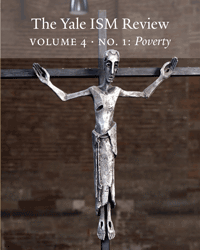 Albert Schilling’s “Suffering Christ” altar cross, pictured on the cover, stands in the Basilica Church of the Redeemer, an Evangelical Lutheran Church in Trier, Germany.
Albert Schilling’s “Suffering Christ” altar cross, pictured on the cover, stands in the Basilica Church of the Redeemer, an Evangelical Lutheran Church in Trier, Germany.
The Basilica Church of the Redeemer was formerly the throne room of the Emperor Constantine. It was badly damaged when the city was bombed during World War II. In its reconstructed form the interior is exceedingly spare and simple. The bare character of the space today is intentional. It expresses the worshipping community’s acute awareness of the need to distance themselves from the building’s former pomp and splendor. Their own description of the church interior expresses it well:
In its unadorned size, the rebuilt Basilika [sic] has reaped the necessary consequences from the experiences of the Nazi era. If the altar of the Protestant church stands where formerly the throne of Roman emperors stood, then the structure must emphasize in its entirety that the power emanating from Jesus Christ differs fundamentally from all worldly claims to power. . . . For what Jesus Christ began is founded not on the power of wealth and money. It is founded on love, the love that God gives to individuals, the love which becomes real in Christ Jesus.
The Schilling altar cross, depicting the suffering Christ, brings into focus the close connection between deprivation and blessing:
This fundamental theological conviction is illustrated by the altar cross. The figure created by Albert Schilling embodies the solidarity of Christ with those who suffer. With his representation of Christ the Basel artist also demonstrates that the compassion of Jesus for the suffering people of the world leads beyond the most extreme consequence of death. The power of powerless love is stronger than the power of death. Thus the Crucified Christ becomes the Resurrected One offering his blessing. The altar cross reveals exactly this, as seen from the side. Schilling’s Christ figure is not hanging on the cross—it is standing in front of it, with hands raised in blessing. Thus the cross becomes the central symbol of Christian hope: death does not have the last word. God’s love leads beyond death.
— Editor